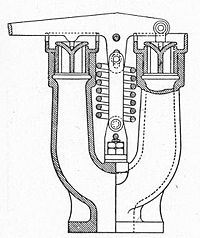Other fittings 8
Let’s continue conversation on safety valves. Such valves in most cases happen odnosedelny, then the barrier mechanism is on the design center. But dvukhsedelny options meet also. Then saddles take place in parallel, and pressing the mechanism is between them. For us big distinctions in the constructive decision are not present.

Fig. 1. Dvukhsedelny safety valve.
Safety valves differ on height of lifting of closing body and on temper of lifting of closing body. On lifting height valves happen low-elevating, srednepodjemny and polnopodjemny. It is defined by need for quantity and speed of a dumped working environment. For household criterion it not the major parameter. And here, temper of lifting is more fascinating. On temper of act there are valves of proportional act and valves of on-off act. Let’s begin with on-off, such valves have only two situation is open and closed, in household criteria they meet while enough occasionally. We remember that after emergency elimination the valve should come back into position. Mechanically it to make rather difficult.
And here, valves of proportional act we in most cases also meet in a life. They received such title therefore that at the moment of a srabotka open not a cavity, and is dependent on superfluous pressure. The spring valve considered by us specifically and works. Such valves for incompressible or low-compressed environments are used. And water concrete that environment also is. Therefore, specifically such safety valves also are vserasprostranenny at housing construction.

Fig. 2. Safety valve.
In the given drawings the lever is perfectly visible, from time to time заместо it it is possible to behold the handle in the form of a fungus. Purpose of that mechanism, is manual dumping for control of a purge of the valve. The matter is that the system can work without emergencies is quite long, and for this period of time with the valve there can be something. It can freeze, become attached etc. Therefore, its working capacity needs to be inspected from time to time.
Continuation follows …






Leave a reply